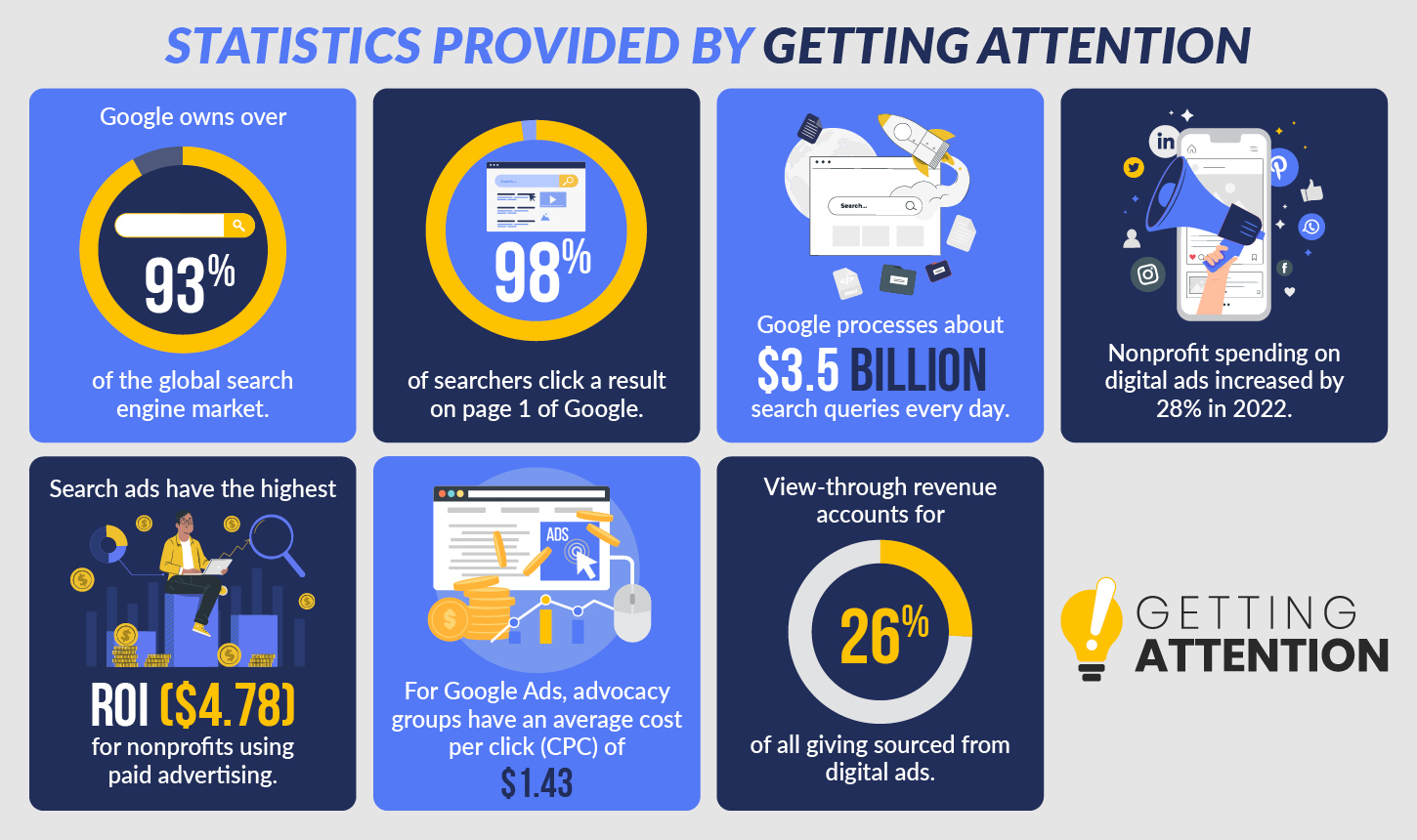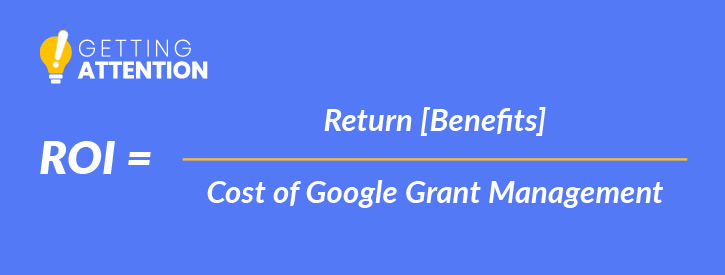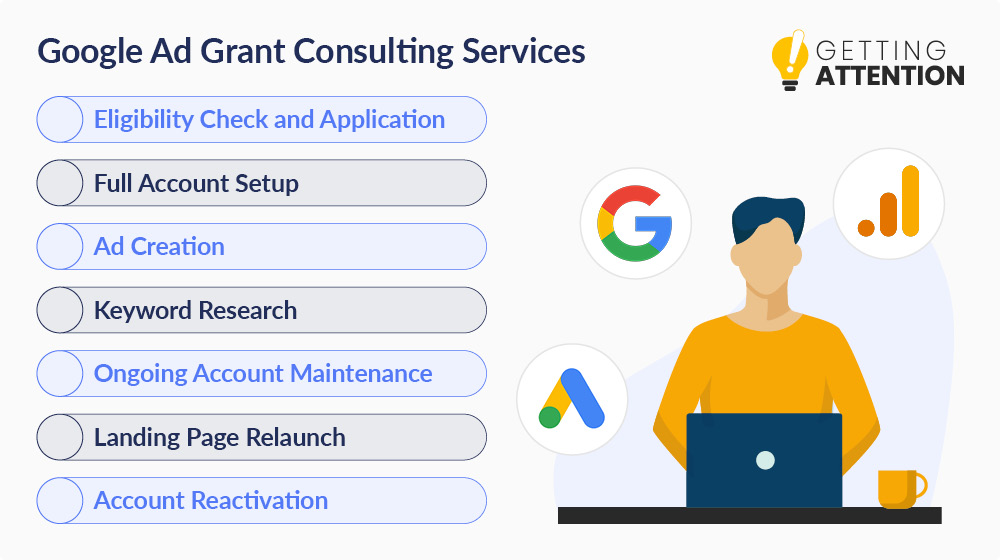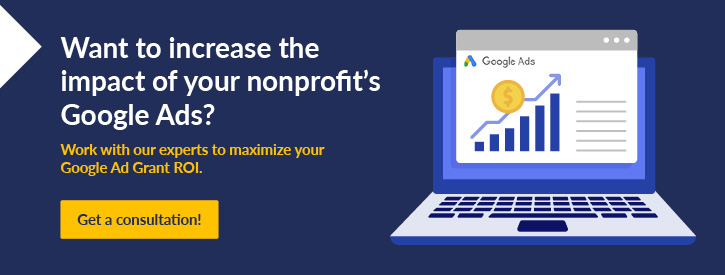Google Ad Grant Impact: Capturing Results and Measuring ROI
As a nonprofit professional, you understand the importance of making the most of every dollar you spend on your mission. Nonprofits operate with limited budgets, so professionals in the sector constantly look for ways to maximize impact without overspending.
If you’ve encountered the Google Ad Grant program, you probably recognize that the program’s valuable. Free advertising money is a clear win for any organization. But what are the exact benefits? How can you calculate what the Google Ad Grant is actually worth to your nonprofit?
We’re here to help you answer those questions and more! That way, you can understand the tangible results the grant provides nonprofits. Then, you can communicate that to your organization’s leadership and get everyone on board. Here’s what we’ll cover:
- Basic Benefits of the Google Ad Grant
- Factors that Impact the Google Ad Grant’s ROI
- Calculating ROI for Your Nonprofit’s Google Ad Grant Account
- When To Expect Results for Your Google Ads
- How to Achieve Results Quickly with the Google Ad Grant
Getting Attention is an official Google Partner, and we work tirelessly with nonprofits to maximize the impact of the Google Ad Grant on their missions. With the right strategy, we’ve seen time and again how the Google Ad Grant can amplify a nonprofit’s presence and turn internet traffic into tangible support.
To learn more about why so many organizations rely on Google Ad Grants, continue reading this article or chat with our experts.
Basic Benefits of the Google Ad Grant
Long story short, if your nonprofit has a website filled with valuable content about your mission, the Google Ad Grant can potentially transform your digital presence. Putting some thought behind your Google Ad Grant strategy means you can:
- Create awareness and buzz for your cause. Strengthen communication with existing supporters and connect with new prospects. You can deliver content to those who are most likely to support your cause, whether they’ve interacted with your team before or are new to your work.
- Boost site engagement. Through your Google Ads, you’ll direct readers to the pages they’ll find most valuable. For example, an ad targeting “animal shelter volunteering” can promote a volunteer page. This brings attention to your most insightful and helpful pages for individual users, thus improving the user experience.
- Increase online conversions. The goal of Google Ad Grant is to drive users to take meaningful actions to support your nonprofit. For our data-focused readers, this can be translated to mean “conversions.” Depending on your goals, you can aim to increase donations, volunteer registrations, email list sign-ups, event registrations, or something else.
There’s really no limit to what you can achieve with the Google Ad Grant. With an astounding $10,000 to spend each month, you can make powerful strides in strengthening your online presence.
Google Ads Statistics
“Engagement,” “awareness,” and “buzz” are all arbitrary. What are the real numbers tied to the impact that the Google Ad Grant has on nonprofits?
While results will vary based on organizations, some pretty impressive statistics communicate the impact the grant has on the industry as a whole:

- Google owns over 93% of the global search engine market, helping nonprofits connect with more prospects than ever before. (source: StatCounter)
- 98% of searchers click a result on page 1 of Google, making the Google Ad Grant a great way to drive more clicks. (source: Nonprofits Source)
- Nonprofit spending on digital ads increased by 28% in 2022, with organizations spending around $0.11 for every dollar raised online. (source: M+R Benchmarks)
- Compared to other platforms, search ads (like Google Ads) have the highest ROI for nonprofits using paid advertising, with an average ROI of $4.78. (source: Double the Donation)
- Google processes about 3.5 billion search queries every day. (source: Internet Live Stats)
- For Google Ads, advocacy groups and nonprofits have an average cost per click (CPC) of $1.43. (source: WordStream)
- View-through revenue (revenue from donors who saw but didn’t click on an ad) accounts for 26% of all giving sourced from digital ads. (source: M+R Benchmarks)
There’s no shortage of impressive statistics out there! Those are just a few of our favorites that speak to the value of the Google Ad Grant.
Factors that Impact the Google Ad Grant’s ROI
As an in-kind donation, the Google Ad Grant itself doesn’t take money out of your marketing budget. Google technically pays for the ads you create through the program.
At a glance, the Google Ad Grant is technically free, so it might seem like there’s no investment necessary. However, acquiring and retaining the grant takes time, expertise, and therefore money.
So, in terms of your investment, the real question you should ask is how much time or money you spend on grant management, rather than how much Google spends to display your ads.
Grant management costs are typically the only investment costs that you’ll have to worry about. Know that professional management can cost anywhere from $500 to over $1,000 per month.

Getting Attention pairs expertise with affordability and professionalism, keeping your grant management costs low. We charge $600 per month with no hidden add-on fees. We’ll handle every aspect of your Google Grant management, helping you to maximize your ROI at every turn.
Calculating ROI for Your Nonprofit’s Google Ad Grant Account
The struggle with calculating marketing ROI is that it’s hard to attach a dollar amount to your results. It’s one of the most elusive metrics for an organization.
What we’ve come to learn is that ROI varies from organization to organization. It depends on your specific goals for the program and what metrics you’re tracking.
Through Google Analytics, you’ll track conversions (or meaningful actions) for your ads. As a reminder, most organizations track:
- Monetary goals: online donations, member sales, event registrations
- Non-monetary goals: volunteer sign-ups, email sign-ups, time spent on site, clicks to call
These actions communicate how much each ad is worth to your organization.
For conversions that produce revenue (like donations), it’s easy to calculate ROI. You simply compare the money you generate from Google Ads with the amount you spend on Google Ad Grant management.
However, non-monetary goals (like volunteer sign-ups) are harder to put a price on. For these, you’ll need to chat with your team about how much each of these conversions is worth to you. You don’t necessarily have to attach a dollar amount, but you can set achievable goals for how many conversions you’d like your ads to produce.
Paid Advertising vs. The Google Ad Grant
When using paid advertising, you pay for each ad yourself. You strive to keep costs down to maximize your ROI. To do this, you might omit competitive (and therefore expensive) keywords and instead focus on less popular queries.
With the Google Ad Grant, you can bid on the most expensive keywords without affecting your ROI.
Whether your Google Ads cost $10 or $10,000, your investment is only what you pay for grant management. Your out-of-pocket costs won’t change. So, if you pay a grant manager $600 per month, you’ll pay the same no matter how much of your grant you spend.
You’ll calculate your ROI based on the real money you spend ($600 in this case) and the results your ads generated (e.g. clicks, conversions, and revenue).
The Bottom Line: The only investment you’ll need to consider is how much you spend on grant management each month. For monetary conversions, you can compare how much you earn with how much you’re spending on grant management. For non-monetary conversions, how much the Google Ad Grant is “worth” fully depends on whether your ads are producing results for your team.
When To Expect Results for Your Google Ads
Applying and getting approved for the Google Ad Grant can take some time. If don’t already have a Google for Nonprofits account, it can take time to get started.
Once you’re up and running, it takes a bit more time to see results from your campaigns. There’s no set guarantee, but generally, you can expect to see some traction a few weeks after launching a campaign.
Within your first month, you’ll start to see some measurable results. Take a look at your Ad Groups, and you’ll start to see clicks for your campaigns.
If you don’t have any conversions yet, don’t worry! The first few weeks can be slow. This time isn’t wasted time, though. Google needs time to gather information about your campaign. It takes a few weeks for Google to learn who to show your campaigns to in order to produce results. In other words, Google wants to serve your ads to the right audiences.
While it varies on a case-by-case basis, Google Ad Grant campaigns generally take 2-3 months to mature and then up to a year to develop into a strong campaign. In rare cases, Google Ads can deliver results overnight. But again, most campaigns won’t generate a positive ROI until a few months in.

Factors That Might Slow Down Results
A few factors might impact how quickly you see results, such as:
- No experience with Google Ads: It can be tempting to follow Google’s recommended settings. Google’s courses are full of reassuring messages about their smart settings, but leaving a new Google Ad Grants account to do whatever is risky. This is why we recommend working with a Google-certified professional who can actively monitor your campaigns.
- Advertising in low-volume niches: Slow-moving campaigns are completely normal for certain niches. If you work on a very specific cause, expect to wait a bit longer to see results.
- Brand new websites: If you just created your website, you’ll have very little (if any) site performance data. You’ll need a month or two to determine which pages on your site are valuable and which aren’t. In this scenario, work with your Google Ad Grants manager to test several approaches to find out what content generates positive campaign results.
- Poorly-designed websites: If your campaigns aren’t producing sufficient conversions, your website might be to blame. Bring your website up to code with the program’s website requirements, or rely on a professional to optimize your landing pages for you.
Help from a professional will help you see better results over time. Even from the get-go, professional consulting services that are Google Partners can help you overcome these challenges, helping you achieve results far faster than by struggling through learning the nuances of the program alone.
How To Achieve Results Quickly With the Google Ad Grant
The secret to effective Google Ad Grant management is research, research, research! The program has a lot of requirements, and you’re expected to navigate some important Google Ad Grants limitations. Because of this, you’ll need to study how to meet these requirements and explore how similar organizations create winning ad campaigns. In many cases, perfecting your ads takes a lot of trial and error, too.
Instead of devoting a staff member’s time to learning about the program, working with a professional who is a Google Partner is your best bet. A Google-certified Google Grants manager will already have the necessary background knowledge regarding how the Google Ad Grants interface and the program as a whole works, so you’ll minimize your costs and maximize your ROI this way.
Here at Getting Attention, we’re a proud Google Partner and strive to help nonprofits make the most of the Google Ad Grant budget. As a full-service Ad Grant consulting firm, we offer these services:
- Eligibility check and Google Ad Grant application
- Full account setup or existing account audit
- Ad creation and keyword research
- Ongoing account maintenance and reporting
- Landing page relaunch
- Account reactivation
Best of all, we aim to keep our costs low at $600 per month. With no hidden add-on fees, your nonprofit can maximize your Google Ad Grant results and generate meaningful conversions for your cause.
Additional Resources
The Google Ad Grant is a powerful resource for any nonprofit that wants to increase its online presence. With the right strategy for your organization, it can have an incredible impact on what you’re able to accomplish.
Marketing ROI can be tricky to calculate in some cases, so it’s important to have some idea of what goals your nonprofit is striving to achieve. Then, you can use that to estimate whether the Google Ad Grant is producing sufficient results.
Whether you’re boosting donations or volunteer sign-ups, you can maximize your ROI by investing in a professional nonprofit marketing consultant. Experts have the background experience necessary to overcome common challenges, write compelling ads, and adjust your campaigns based on results. If you’re ready to get started, reach out to our expert Google Grants management team.
In the meantime, remember that the secret to maximizing your Google Ad Grant ROI is research! Explore these resources to learn everything you need to know about the program:
- Google Ad Grants for Nonprofits: The Complete Guide. Dive into everything there is to know about Google Ad Grants. From what the grant is to actionable tips for improving results, this ultimate guide covers what you need.
- Hiring A Google Grants Manager: A Guide & 9 Agencies. Learn what it’s like to hire and work one-on-one with a Google Ad Grants agency in this guide from Nonprofits Source.
- Google Grants Eligibility: Is Your Nonprofit Eligible? Before applying for the program and planning how you’ll maximize results, find out if your organization is eligible.







